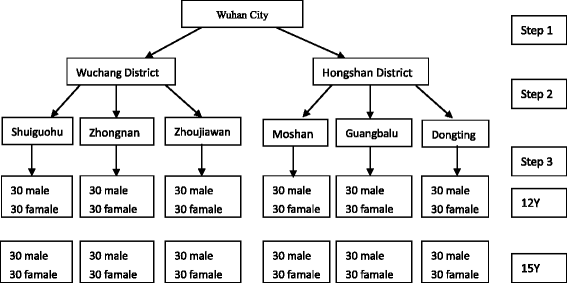The prevalence and risk indicators of tooth wear in 12- and 15-year-old adolescents in Central China
- PMID: 26453049
- PMCID: PMC4599587
- DOI: 10.1186/s12903-015-0104-9
The prevalence and risk indicators of tooth wear in 12- and 15-year-old adolescents in Central China
Abstract
Background: Tooth wear has been investigated in numerous countries, and the prevalence has varied. However, the data on tooth wear in China are scarce. The aim of this study was to describe the prevalence of tooth wear and to investigate the relative indicators associated with tooth wear in 12- and 15-year-old adolescents in Wuhan City, Hubei Province, Central China.
Methods: A cross-sectional descriptive study was undertaken among 720 adolescents in Hubei Province, Central China. The age groups in this study were 12- and 15-year-old, and each group consisted of 360 participants in which females and males represented 50 % each. A modified version of the Basic Erosive Wear Examination (BEWE) tooth wear index was used for the buccal, cervical, occlusal/incisal and lingual surfaces of all of the teeth in the 720 adolescents. All of the participants were asked to answer a questionnaire consisting of questions about their current and historical dietary habits and oral hygiene.
Results: The prevalence of tooth wear was 18.6 and 89.4 % in 12- and 15-year-old adolescents, respectively. The prevalence rates of dentin exposure were 1.9 and 5.6 %, respectively. A significantly higher prevalence of tooth wear and dentin exposure in 15-year-old adolescents was found than in 12-year-old adolescents (p < 0.001 and p = 0.011). Several factors such as drinking soft drinks and fruit juices immediately after sports, taking aspirin, reflux, unilateral chewing, tooth brushing once daily or less often, duration of brushing less than 2 min and swimming in the summer were found to be associated with tooth wear.
Conclusions: Tooth wear in 12- and 15-year-old adolescents in Central China is a significant problem and should receive greater attention. The prevalence of tooth wear increases with age and associated with socio-behavioral risk factors.
Figures
References
-
- Ramalho A, Miranda J. The relationship between wear and dissipated energy in sliding systems. Wear. 2006;260:361–7. doi: 10.1016/j.wear.2005.02.121. - DOI
-
- Eccles JD. Tooth surface loss from abrasion, attrition and erosion. Dental Update. 1982;9(7):373–81. - PubMed
-
- Zum Gahr KH. Classification of wear processes. Microstructure and wear of materials. 1987;10:80–131. doi: 10.1016/S0167-8922(08)70722-3. - DOI
MeSH terms
LinkOut - more resources
Full Text Sources
Other Literature Sources


